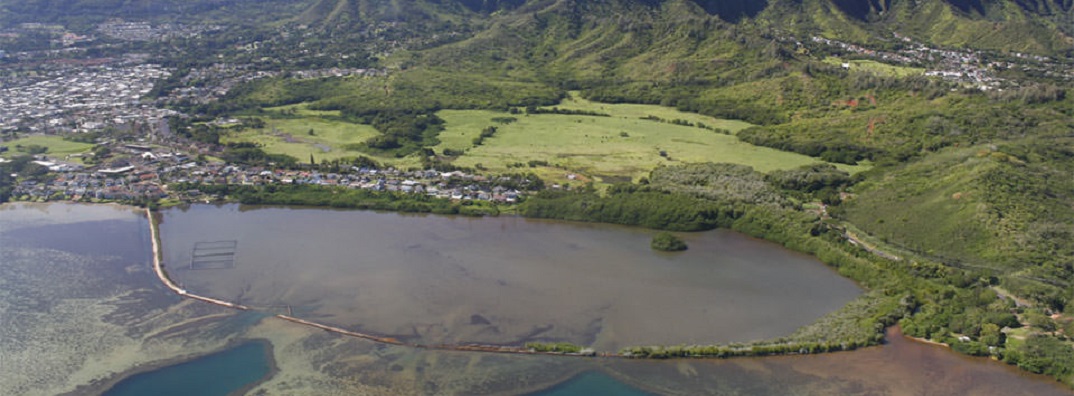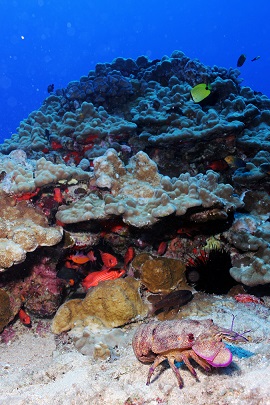- ABOUT US
- PROGRAM AREAS
- CONSERVATION APPROACH
- EDUCATION
- MULTIMEDIA
Hawaii's New Decade of Building Coral Reef Ecosystem Resilience
By Leanne Poussard, Knauss Marine Policy Fellow

Coral reefs across the Hawaiian Islands have important cultural and economic value. However, land-based sources of pollution, increased sea surface temperatures, macro algae overgrowth, and disease outbreaks all affect coral health. Resilience—the capacity to recover from a disturbance and maintain or reestablish a diverse and rich reef ecosystem—is a primary objective for coral reef ecosystems in conservation and restoration. Resiliency is therefore an integral part of Hawaii’s Coral Reef Strategy 2030. The Hawaii Department of Land and Natural Resources’ Division of Aquatic Resources developed the strategy to best strategize how to protect, conserve, and restore coral reef ecosystems over the next decade.
The Hawaii Coral Reef Strategy 2030 emphasizes the inclusion of communities in coral restoration and conservation, and the need to work mauka to makai, from ridge to reef (or literally, toward the mountains and toward the sea), to promote reef resilience. The strategy calls for local government to work with members of the communities, such as fishery managers and fishers, to share fishery best practices, to implement education and outreach initiatives that serve residents and visitors to the islands, and to collaborate with residents and business owners to prevent and mitigate land-based sources of pollution in watersheds.

The strategy promotes the creation of opportunities for public participation in restoration activities through outreach and education events, trainings, and workshops. The strategy also emphasizes collaborative coral research processes in which the local government, partners, and the scientific community share and discuss current scientific findings and theories for the benefit of the state’s coral restoration and monitoring projects. The Hawaii Coral Reef Strategy 2030 interconnects with ongoing management plans as well, such as Hawaii's Community-Based Fishing Areas and the 30x30 Management Plan, the Department of Aquatic Resources’ commitment to effectively manage 30 percent of inshore waters by 2030.
The effects of climate change and anthropogenic pollutants have been harming coral reef ecosystems in Hawaii for years. The local government and community organizations have been working to create restoration initiatives to increase coral reef resilience and recovery in these populations. The Hawaii Coral Reef Strategy 2030 builds upon progress and successes in coral restoration to establish a solid foundation for reef resilience, and continues to honor and respect local initiatives by building capacity and uplifting community leadership in coral reef conservation. This initiative leverages the collective strength of many scientists, managers, and community members to achieve coral resilience goals in Hawaii and to inform coral reef management across the country.
About Us

The NOAA Coral Reef Conservation Program was established in 2000 by the Coral Reef Conservation Act. Headquartered in Silver Spring, Maryland, the program is part of NOAA's Office for Coastal Management.

The Coral Reef Information System (CoRIS) is the program's information portal that provides access to NOAA coral reef data and products.
Work With US
U.S. Coral Reef Task Force
Funding Opportunities
Employment
Fellowship Program
Contracting Assistance
Graphic Identifier
Featured Stories Archive

Access the archive of featured stories here...
Feedback
Thank you for visiting NOAA’s Coral Reef Conservation Program online. Please take our website satisfaction survey. We welcome your ideas, comments, and feedback. Questions? Email coralreef@noaa.gov.
Stay Connected
Contact Us
NOAA’s Coral Reef Conservation Program
SSMC4, 10th Floor
1305 East West Highway
Silver Spring, MD 20910
coralreef@noaa.gov
